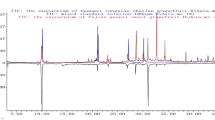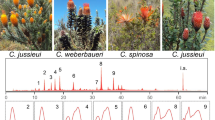Abstract
There has been a growing trend in consumer’s preferences for food supplements containing propolis due to having a wide range of phenolic compounds to promote health. Honeybees’ used main plant source will determine propolis chemical composition thus its biological activity. Thus, determination of the propolis botanical source is highly important for its standardization and prediction of its pharmacological activity. There are two commonly applied methods to seek propolis botanical sources: chromatographic techniques and palynological analysis. In this study, high-performance thin-layer chromatography (HPTLC) and ultra-high-performance liquid chromatography combined with mass spectrometer (LC-MS/MS) applied comparatively with pollen analysis to propolis samples. The results of the chromatographic analyses were evaluated with principal component analysis (PCA) and hierarchical clustering analysis (HCA). Consequently, chromatographic techniques applied in this study were found to be superior to pollen analysis to identify the main plant source of propolis. Besides, HPTLC images revealed not only main botanical sources but also minor sources of propolis. Therefore, HPTLC fingerprinting combined with PCA and HCA resulted in grouping propolis samples according to geographical regions. This study may lead to pharmaceutical industries for the quality assurance of propolis while preparing standardized propolis formulations in the market with desired pharmacological properties.









Similar content being viewed by others
Data availability
All datas are included in the current article.
References
Kuropatnicki AK, Szliszka E, Krol W (2013) Historical aspects of propolis research in modern times. Evid.-based Complement. Altern Med 2013:964149
Bogdanov S, Bankova V (2017) Propolis: Origin, production, composition, The Propolis Book, Chapter 1, Bee Product Science.
Popravko SA, Gurevich AI, Kolosov MN (1969) Flavonoid components of propolis. Chem Nat Compd 5(6):397–401
Bankova V, Popova M, Trusheva B (2006) Plant sources of propolis: an update from a chemist’s point of view. Nat Prod Commun 1(11):1023–1028
EFSA Panel on Dietetic Products, Nutrition and Allergies (NDA) (2010) Scientific opinion on the substantiation of health claims related to propolis (ID 1242, 1245, 1246, 1247, 1248, 3184) and flavonoids in propolis (ID 1244, 1644, 1645, 3526, 3527, 3798, 3799) pursuant to Article 13 (1) of Regulation (EC) No 1924/2006. EFSA 8(10):1810
Guzelmeric E, Yuksel PI, Yaman BK, Sipahi H, Celik C, Kırmızıbekmez H, Aydın A, Yesilada E (2021) Comparison of antioxidant and anti-inflammatory activity profiles of various chemically characterized Turkish propolis sub-types: Which propolis type is a promising source for pharmaceutical product development? J Pharm Biomed Anal 203:114196
Sforcin JM, Bankova V (2011) Propolis: Is there a potential for the development of new drugs? J Ethnopharmacol 133(2):253–260
Fedotova VV, Konovalov DA (2019) Propolis research in Russia. Indian J Pharm Educ Res 53:500–509
Kumazawa S, Yoneda M, Shibata I, Kanaeda J, Hamasaka T, Nakayama T (2003) Direct evidence for the plant origin of Brazilian propolis by the observation of honeybee behavior and phytochemical analysis. Chem Pharm Bull 51(6):740–742
Silva BB, Rosalen PL, Cury JA, Ikegaki M, Souza VC, Esteves A, Alencar SM (2008) Chemical composition and botanical origin of red propolis, a new type of Brazilian propolis. Evid Based Complement Altern Med 5(3):313–316
Kumazawa S, Nakamura J, Murase M, Miyagawa M, Ahn MR, Fukumoto S (2008) Plant origin of Okinawan propolis: honeybee behavior observation and phytochemical analysis. Naturwissenschaften 95(8):781–786
Cuesta-Rubio O, Frontana-Uribe BA, Ramírez-Apan T, Cárdenas J (2002) Polyisoprenylated benzophenones in Cuban propolis; biological activity of nemorosone. Z Naturforsch C J Biosci 57(3–4):372–378
Tomás-Barberán FA, García-Viguera C, Vit-Olivier P, Ferreres F, Tomás-Lorente F (1993) Phytochemical evidence for the botanical origin of tropical propolis from Venezuela. Phytochem 34(1):191–196
Barth OM (1998) Pollen analysis of Brazilian Propolis. Grana 37:97–101
Barth OM, Luz CFPD (2003) Palynological analysis of Brazilian geopropolis sediments. Grana 42(2):121–127
Louveaux J, Maurizio A, Vorwohl G (1978) Methods of melissopalynology. Bee World 51(3):139–157
Reich E, Schibli A (2007) High performance thin layer chromatography for the analysis of medicinal plants. Thieme, Stuttgart
Guzelmeric E, Sipahi H, Özhan Y, Hamitoğlu M, Helvacıoğlu S, Düz G, Akyıldız IE, Kadıoğlu Yaman B, Hazar M, Dilsiz Aydın S, Aydın A, Yesilada E (2023) Comprehensive estrogenic/anti-estrogenic, anticancer, mutagenic/anti-mutagenic, and genotoxic/anti-genotoxic activity studies on chemically characterized black poplar and Eurasian aspen propolis types. J Pharm Biomed Anal 226:115241
Guzelmeric E, Özdemir D, Sen NB, Celik C, Yesilada E (2023) Quantitative determination of phenolic compounds in propolis samples from the Black Sea Region (Türkiye) based on HPTLC images using partial least squares and genetic inverse least squares methods. J Pharm Biomed Anal 229:115338
Isidorov VA, Szczepaniak L, Bakier S (2014) Rapid GC/MS determination of botanical precursors of Eurasian propolis. Food Chem 142:101–106
Okińczyc P, Szumny A, Szperlik J, Kulma A, Franiczek R, Żbikowska B, Krzyżanowska B, Sroka Z (2018) Profile of polyphenolic and essential oil composition of Polish propolis, black poplar and aspens buds. Molecules 23(6):1262
Chasset T, Häbe TT, Ristivojevic P, Morlock GE (2016) Profiling and classification of French propolis by combined multivariate data analysis of planar chromatograms and scanning direct analysis in real time mass spectra. J Chromatogr A 1465:197–204
Devkota HP (2022) An overview of medicinal plants of the Asteraceae family and their role in human health. In: Devkota HP, Aftab T (eds) Medicinal plants of the asteraceae family: traditional uses, phytochemistry and pharmacological activities. Springer, Singapore
Kolaylı S, Birinci C, Kara Y, Ozkok A, Samancı AET, Sahin H, Yildiz O (2023) A melissopalynological and chemical characterization of Anatolian propolis and an assessment of its antioxidant potential. Eur Food Res Technol 249(5):1213–1233
Ristivojević P, Andrić FL, Trifković JĐ, Vovk I, Stanisavljević LŽ, Tešić ŽL, Milojković-Opsenica DM (2014) Pattern recognition methods and multivariate image analysis in HPTLC fingerprinting of propolis extracts. J Chemom 28:301–310
Pilario KE, Tielemans A, Mojica ERE (2022) Geographical discrimination of propolis using dynamic time warping kernel principal components analysis. Expert Syst Appl 187:115938
Altuntaş Ü, Güzel İ, Özçelik B (2023) Phenolic constituents, antioxidant and antimicrobial activity and clustering analysis of propolis samples based on PCA from different regions of Anatolia. Molecules 28(3):1121
Acknowledgements
Etil Guzelmeric thanks to Özen Altıparmak (Altıparmak Food Industry and Trade Inc.) for providing laboratory facilities.
Author information
Authors and Affiliations
Corresponding author
Ethics declarations
Conflict of interest
The authors declare no conflict of interest.
Compliance with ethics requirements
There is no use of human participants or animal subjects.
Additional information
Publisher's Note
Springer Nature remains neutral with regard to jurisdictional claims in published maps and institutional affiliations.
Rights and permissions
Springer Nature or its licensor (e.g. a society or other partner) holds exclusive rights to this article under a publishing agreement with the author(s) or other rightsholder(s); author self-archiving of the accepted manuscript version of this article is solely governed by the terms of such publishing agreement and applicable law.
About this article
Cite this article
Guzelmeric, E., Daştan, T., Sen, N.B. et al. Comparison of palynological method and chromatographic analysis combined with chemometrics to identify botanical origin of propolis. Eur Food Res Technol 250, 727–743 (2024). https://doi.org/10.1007/s00217-023-04420-9
Received:
Revised:
Accepted:
Published:
Issue Date:
DOI: https://doi.org/10.1007/s00217-023-04420-9




